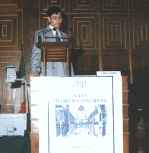 THE USE OF GC/MS/MS FOR THE DETECTION OF AN UNCOMMON BENZODIAZEPINE IN A URINE SPECIMEN
THE USE OF GC/MS/MS FOR THE DETECTION OF AN UNCOMMON BENZODIAZEPINE IN A URINE SPECIMEN
Chan T.W.D., Mok K.K.V.
Government Laboratory, Homantin Government Offices, 88 Chung Hau St., Homantin, Kowloon, Hong Kong
An uncommon benzodiazepine, namely 5(2-chlorophenyl)-1,3-dihydro-2H-1,4- benzodiazepin-2-one or desnitroclonazepam, was detected in a urine specimen from the victim of a rape case. The victim alleged that she felt drowsy and fainted after consuming a glass of soft drink given by the suspect. Due to the strong indication of the victim being doped, a systematic screening procedure for drugs including common benzodiazepines by using GC/MS was performed although the initial screening for the presence of benzodiazepine by EMIT gave a negative result. Extracts were prepared by alkalization of the urine specimen with sodium bicarbonate and extraction with a solvent mixture of dichloromethane : toluene : isobutyl alcohol (3:6:1 v/v) containing prazepam as an internal standard. The extract was further cleaned up by partition between hexane and aqueous ethanol (80 % v/v) before injecting into the GC/MS. Through library searching with the NBS mass spectral library, GC/MS analysis suggested the presence of an uncommon benzodiazepine of the structure either 5(2-chlorophenyl)-1,3-dihdro-2H-1,4-benzodiazepin-2-one or 6-chloro-1,3-dihydro-5-phenyl-2H-1,4-benzodiazepin-2-one (both are non-proprietary benzodiazepines) as their mass spectra are very similar. The only difference in these two benzodiazepines lies in the position of the chlorine atom attached either to the phenyl substituent or the benzodiazepine ring. Based on this difference, clonazepam and nordiazepam were chosen and subjected, in parallel with the unknown, to a series of GC/MS/MS experiments. Their corresponding molecular ions, 315 and 270, were isolated and subjected to collision induced dissociation (C.I.D.) at various collision energies ranging from 0.5 eV to 2.0 eV. Significant difference in the daughter ion mass spectra were observed. The daughter ion spectrum of the unknown compound was similar in pattern to that of clonazepam but differed greatly from that of nordiazepam. This information led to the deduction of the presence of desnitroclonazepam in the urine sample and was finally confirmed with the authentic standard kindly provided by F. Hoffman-La Roche AG Company.
|